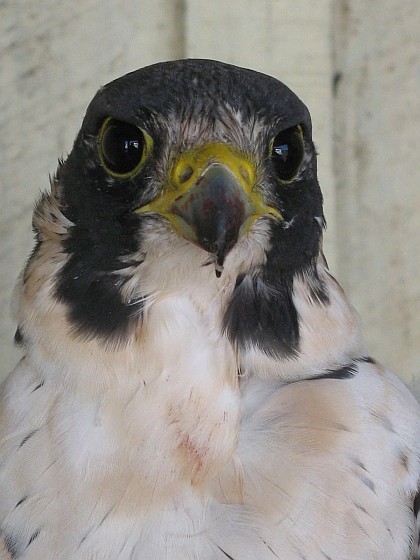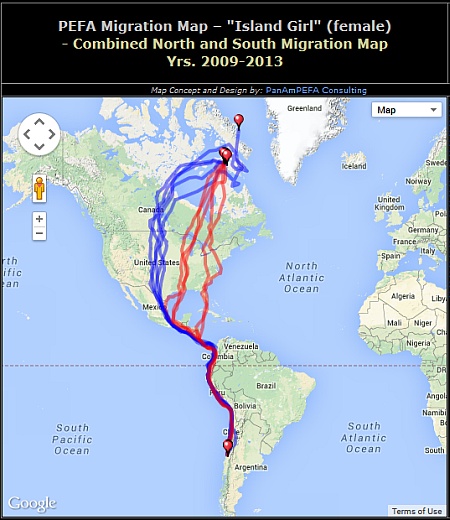
NOTE(*) SEPTEMBER 2021: The Southern Cross Peregrine Project and Falcon Research Group websites no longer exist. Seven years later it is no longer possible to follow this peregrine… if she exists.
29 September 2014
Since 2007 the Falcon Research Group’s Southern Cross Peregrine Project (SCPP) has satellite-tracked some of the longest migrating peregrines in the Western Hemisphere. Tagged at their wintering grounds on the coast of Chile, these peregrines have shown amazing stamina as they travel back and forth from Chile’s coast to the tundra cliffs of northern Canada.
Over the years the project has tracked 13 birds but now only “Island Girl,” pictured above, has a working transmitter. First tagged in 2009 she’s provided many years of data.
In the screenshot below SCPP mapped her 2009-2013 north and south migrations. As you can see she changes her route a bit year to year and season to season. Heading south (red) she prefers to fly the shortest route to Chile, often across the Gulf of Mexico. On her way north (blue) she travels by land and arcs across central Canada.
Winter comes early to the Arctic so Island Girl began her southward journey this month, leaving her Baffin Island home on September 17. By the time she roosted last night she’d already traveled 1,478 miles and was spotted by satellite at Vandeleur, Ontario just west of Eugenia Lake.
Where will she go today?
NOTE in 2021: The tracking website no longer exists. These instructions don’t work. Click here for Island Girl’s Tracking Page or click here for detailed location maps.
Follow an arctic peregrine as she migrates over North America on her way to Chile. Go, Island Girl!
(photo and map from the Falcon Research Group’s Southern Cross Peregrine Peregrine Project. Click on the images to see the originals)

Hello!This has nothing to do with the lovely birds(particularly like the photo of yellow male).
Today,I was on the dirt road of the property where I work near Indiana PS,when I saw a fairly large turtle. I had to move him in order not to run over him, so I stopped the car and got out.I tried picking him up with my hand outstretched across the back like they do on TV,etc. NOTHING doing!I couldn’t budge him.So I went to the front and slowly got closer, then as my hand got near, he SNAPPED! Then,I got a large twig from a nearby tree, just big enough to budge him-but HARDLY. It was like he was glued to the ground…As I went towards him, he’d back up so I used that to back him to the side of the road. I laid the twigs beside him &some fronds of grass& weeds over him: Then I was able to drive through..
So I have a few questions, if you’d be good enough to answer? 1.Is it mating season for turtles?Near the same spot,there’s a large pond& someone recently caught a turtle,est.50 years old. It was about 2 1/2 feet across.
2.Would this have been more likely a male or female? It was about a foot wide.
3.Do they ‘play dead’?Is that why it wasn’t moving?Do they have something on their feet that gives them traction on dirt?
It was such a great experience& the turtle was so cute!Thanks for any info!
By the way,the blue herons did return very briefly-only about a week-early this summer.But sure hope they keep coming back,so beautiful.The Canadian geese haven’t arrived yet.
Keep you posted.
These maps are very neat! The over the ocean going and stick to land route back is similar to what ospreys do. They must get to the tip of Florida, say “Oops!” and continue over the ocean. Great website they have!